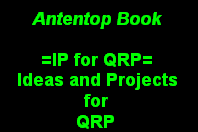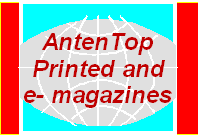

Antentop is FREE e-magazine devoted to Antennas and Amateur Radio an
Special page devoted to
A Simple SSB Transceiver

Custom Search
|
ANTENTOP-
01- 2004, # 005 |
A
Simple SSB Transceiver
|
|
|
|
|
|
|
|
|
|
|
►Pass
the twisted pair through one hole to the other side, bend the
wire back and pass it back through the other hole (like a U turn).
This is one turn, like this, make similar 10 turns. Making a trifilar
transformer is similar, except that you have to use three wires
twisted together. Separate out the three wires as before, use
the first two as described above, and the third winding as the
secondary. IF
sub-system
The crystal
filter and its associated IF circuitry is shared between the receiver
and transmitter. Although the crystals are inexpensive enough
to be able to afford separate filters for the transmitter and
the receiver, we noted that each filter would have a different
center frequency. This would make zero-tuning difficult for SSB
operation. Therefore, it was decided to share the same crystal
filter, carrier oscillator and the VFO between transmit and receive
functions. |
the same value as
the terminating filter impedance across the input and output ends
of the filter. This is incorrect. This looks like a resistor that
is paralleled with a reactive impedance of the rest of the circuitry
attached to the filter. When the crystal filter is not properly
terminated and sees reactive termination, ripple and ringing are
introduced. This will spoil the crispness of the receiver and
spoil your on-the-air quality. The crystal filter
is terminated on both sides by 'strong' RC coupled amplifiers
based on 2N3866. This is slightly unusual. The 2N3866 is used
mostly as a VHF power amplifier. It has excellent low-noise characteristics,
good gain and using it as a small signal device is now an established
practice. The 2N3866 is an expensive transistor. It costs about
Rs.20 in the open market. We think it is a good investment. Most designs we
have studied couple the RF input to the diode detector through
the transformer and inject the BFO at the center of the transformer.
This is a wrong practice. The diode mixer requires a minimum of
5mW of energy from the transformer input to operate properly.
There should be enough energy to switch on both the diodes. This
means about 1.2 v peak voltage. The received
signals are rarely this level. As a result, the product detector
operates like a regular envelope detector and the diodes act as
distortion devices to mix the BFO with the signal. The correct
configuration is to inject the BFO across the transformer |
|
|
|
|
|
Page 67 |
 |
 |
 |
 |
Just for Fun:

Powered byIP2Location.com
Thanks for your time!
Last Updated:
February 25, 2020 22:18





